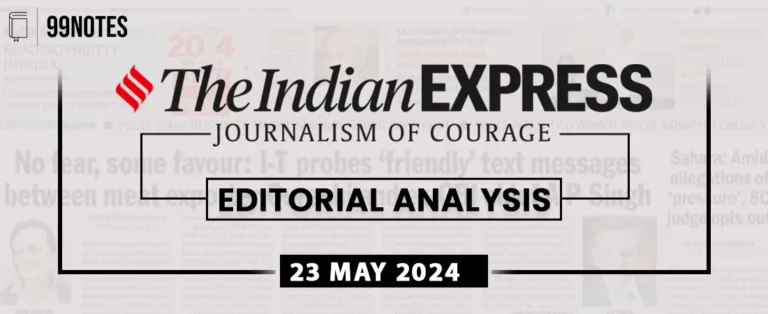25 September 2023 : Indian Express
Indian Express
25-September-2023
The Indian Express, CSE candidates can stay informed about current events and developments in India and around the world.
1) Women’s Reservation Bill: The Inclusion test
Context:
- The Constitution (ONE Hundred and Twenty-Eighth Amendment) Bill, 2023 or the women’s reservation Bill was introduced in the Lok Sabha on September 19 during the special session of Parliament, under a new name, Nari Shakti Vandan Adhiniyam.
- It was passed by an over whelming majority of 454 votes in favour and only two against, on the very next day.
- This article will discuss both the expected positive outcomes as wellas the reasons for criticism of the bill.
Key features of the bill:
Reservation:
- The legislation seeks to allocate 33 percent seats in the state and central legislative bodies for women which, at present, is abysmally low, around 15 percent in the Lok Sabha and 12 per cent in the Rajya Sabha.
- According to the Inter-Parliamentary Union, India ranks 148th out of 193 countries in terms of women’s representation while the global average is 26.5 per cent.
- Similarly, women’s representation in state assemblies is also dismal, ranging from 1 per cent in Nagaland to 23.1 per cent in Bihar.
- The Bill aims to increase the number of women MPs to 181 from the current 82 and women MLAs to more than 2,000 from the current 740.
Current Scenario of Women’s representation:
- There has been a gradual increase in the number of female MPs in the Lok Sabha from a mere 5 per cent in the first Lok Sabha to 15 per cent in the current 17th Lok Sabha.
- A total of 716 female candidates participated in the 2019 general elections, out of which 78 were successfully elected. This is about a third higher than the previous election in 2014, where 62 women MPs were elected.
- Similarly, the present Rajya Sabha consists of 224 members, out of which 24 are women.
- At present, there are a total of 102 women parliamentarians.
Majority required: The Women Reservation Bill would require a special majority of the Parliament and ratification by half of the states. That is a two-thirds majority in both the Houses of Parliament and the approval from at least 50% of states.
Earliest implementation: However, the earliest moment when one-third of the seats in the Lok Sabha is likely to be occupied by women in 2029.
This is because the Bill says that the “provisions relating to the reservation of seats for women shall come into effect after an exercise of delimitation is undertaken for this purpose after the relevant figures for the first census taken after (the Bill is passed) have been published.”
This provision of the fresh census and delimitation exercise was not part of the Women’s Reservation Bill passed by the Rajya Sabha in 2010.
Significance of the Women’s Reservation Bill
Gender Equality
- Historical Underrepresentation: Historically, women have been significantly underrepresented in India’s political landscape. This underrepresentation perpetuates gender inequality as it restricts women’s ability to influence policies and decisions that affect their lives.
- Political Empowerment: The Women’s Reservation Bill aims to rectify this historical imbalance by reserving a certain percentage of seats in the Lok Sabha and State Legislative Assemblies for women. This proactive measure ensures that women have a fair opportunity to participate in the highest levels of decision-making in the country, promoting gender equality in politics.
- Symbolic Importance: Beyond the practical implications, the bill carries immense symbolic importance. It signifies that Indian society recognizes and values the contributions of women in politics, sending a message that women’s voices and perspectives are essential in shaping the nation’s future.
Empowerment
- Access to Political Arena:The Women’s Reservation Bill empowers women by granting them equal access to the political arena. It breaks down traditional barriers and prejudices that may have discouraged women from entering politics in the past, such as social norms and lack of opportunities.
- Enhancing Political Skills: As more women enter politics and gain experience, it helps in building their leadership and governance skills. This empowerment extends beyond politics, as women who succeed in the political sphere can become role models for others, inspiring greater participation in various fields.
- Policy Influence: Through political participation, women gain the power to influence policies that directly impact their lives and those of their communities. This empowerment translates into tangible changes in areas such as healthcare, education, gender-based violence, and economic opportunities.
Diverse Perspectives
- Addressing Gender-Specific Issues: Increased female representation in politics brings attention to gender-specific issues that may have been overlooked in the past. Women often advocate for policies related to maternal health, childcare, gender-based violence, and economic opportunities that directly affect women and families.
- Enhancing Decision-Making: Diverse perspectives lead to more comprehensive and balanced decision-making. When women are actively involved in policymaking, the resulting laws and regulations are more likely to consider the needs and interests of the entire population, not just a segment of it.
- Social and Cultural Change: Female political leaders can challenge traditional gender roles and norms, inspiring broader social and cultural change. Their presence in politics can help break down stereotypes and create a more inclusive and gender-equal society.
Criticism of the Bill:
The Bill has also faced some criticisms from various groups, who have raised concerns about its feasibility, desirability, and implications
Concerns about Existing Reservations
- Foremost is the concern that the Bill will create divisions among women based on caste, religion, region, and class.
- Some parties have demanded that within the 33 per cent reservation for women, there should be a sub quota for women from backward classes and minorities.
- Without such a provision, the Bill will benefit only upper-caste and urban women at the expense of lower-caste and rural women.
- However, some others have opposed this demand, on the ground that it will further fragment society along communal lines and undermine unity and solidarity among women.
Concerns about merit and competence of legislators
- By reserving seats for women based on gender alone, the Bill may compromise the quality and efficiency of governance.
- In some instances, women may be nominated by male relatives or patrons who will influence their decisions.
- Women candidates may lack the necessary experience, education, skills, and vision to perform their duties effectively.
- It may also lead to perpetual inequality as they would be perceived as not competing on merit.
Concerns about existing electoral system and political dynamics
- By reserving seats for women by rotation, the Bill may create instability and uncertainty in the electoral process.
- This may affect the continuity and accountability of legislators who will have to change their constituencies frequently.
- It may affect the loyalty and representation of voters who will have to choose from among different candidates every time.
Way Forward:
- The Women’s Reservation Bill, with its goal of reserving 33% of seats for women in Parliament and legislative assemblies, represents a significant step toward achieving gender equality in Indian politics.
- However, overcoming political challenges and societal norms remains crucial for its successful implementation.
- Advocacy, public awareness, and consensus-building efforts are essential for moving forward with this important legislation.
2) New momentum in ties between India and Saudi Arabia
Context:
- The recently concluded state visit to India by the Crown Prince of Saudi Arabia, Muhammad bin Salman (MBS) in conjunction with the G20 Summit in New Delhi ensured that the relations between both the countries gain exponential momentum.
- This article will cover the various aspects about the bilateral ties between both the countries that would support the narrative that both countries have indeed reached new heights in their relationship.
Key Details:
Various MoUs signed
- The India-Saudi bilateral meet immediately after the G20 summit saw the conclusion of eight major MoUs (involving vigilance, financial regulation and exim banks, desalination technology) and several other minor understandings (ranging from IT, petrochemicals, pharmaceuticals, new “clean” energy technology, manufacturing and defence).
Trade statistics:
- India is Saudi Arabia’s second-largest trading partner.
- Saudi Arabia is India’s fourth largest trading partner.
- Trade between the two countries touched $52.75 billion in the 2022-23 fiscal year, and until being displaced by Russiain the last financial year, Saudi Arabia has been India’s largest source of crude imports for nearly a decade ($29 billion in the 2022-23).
Indian Expatriates in Saudi Arabia
- India has a large number of expatriates based in Saudi Arabia in both the skilled and unskilled sectors.
- Have been earmarked a quota of 175,000 pilgrims for the annual Hajj.
How trade in Oil became the core element in Indo-Saudi relations?
- The core element in Indo Saudi relations continues to revolve around energy, especially Saudi export of crude oil.
- India’s reliance on Saudi oil exports dates back to the 1960s, but India used to buy a greater volume of her crude from among the lighter crude that came from the north side of the Persian Gulf (Iraq and Iran) rather than the Arab Gulf states, because Indian refineries were better equipped to handle that variety.
- It was only with the fall in the volume of Iraqi exports from the 1990s, and then with the 2010 sanctions regime imposed on Iran by the USA, EU and their allies, that India began to proportionately increase her import of Saudi crude.
- WEST COAST REFINERY PROJECT (WCRP): West Coast refinery project will be India’s first and largest greenfield refinery project with a production capacity of 60 million tonnes per annum and is touted to become the largest integrated refinery and petrochemical facility in the world.
Investment in Gujarat:
- MBS has reconfirmed Saudi intention of investing another $50 billion and setting up an office for the Saudi Sovereign Wealth Fund in Gujarat International Fin Tech-City.
- This landmark initiative involves collaboration among key organizations, including the Federation of Indian Chambers of Commerce and Industry (FICCI), Invest India, and the Ministry of Commerce and Industry.
Naval Operation:
- As a testimony to this reasonably swift improvement of bilateral ties, the Saudi navy was recently found taking exemplary measures for the safe extraction of Indian expatriates caught up in Port Sudan.
India-Middle East-Europe Economic Corridor (IMEC)
- The prospective collaboration of both the countries on the new proposed port and rail road corridor of IMEC is likely to integrate the two countries in a way to the global supply chain that has not happened since the Portuguese discovery of the sea route to India in the 15th century.
- This corridor can be developed with a focus on sustainability, aligning with India’s green transition goals, elevating the nation’s regional prominence, and enabling Indian enterprises to participate equitably in infrastructure development.
- Additionally, the corridor promises to secure supply chains, generate employment opportunities, and enhance trade facilitation and accessibility.
BRICS Membership:
- India’s support for the induction of Saudi Arabia as a permanent member of BRICS further signals the positive relation between both the countries.
How will India benefit?
- Saudi investment would provide India with a kind of foreign capital that may not be as susceptible to knee-jerk reactions as Western capital often has been.
- The issue of India’s energy security will also be addressed in a big way.
Way Forward:
- Such engagements between both the nations signals a new uplifted momentum in bilateral ties and hence it was very important to ensure that constructive steps are taken to keep it going.
For Enquiry

25 September 2023 : Indian Express

25 September 2023 : PIB

25 September 2023 : Daily Current Affair

25 September 2023 : The Hindu Editorial Notes PDF

23 September 2023 : Daily Quiz

23 September 2023 : Daily Answer Writing

23 September 2023 : Indian Express

23 September 2023 : PIB

23 September 2023 : Daily Current Affair

23 September 2023 : The Hindu Editorial Notes PDF
Indian Express 25 September 2023 : Indian Express Indian Express
23-September-2023
The Indian Express, CSE candidates can stay informed about current events…
PIB 25 September 2023 : PIB PRESS INFORMATION BUREAU
25-September -2023
Daily Current Affairs For UPSC ,The PIB ( Press Information…
Daily Current Affairs 25 September 2023 : Daily Current Affair Daily Current Affairs
25-September-2023
Daily Current Affairs For UPSC ,Daily Current affairs of The…
September- The Hindu Editorial 25 September 2023 : The Hindu Editorial Notes PDF The Hindu Editorial
25-September-2023
Daily Current Affairs For UPSC ,The Hindu Editorial Summary
Facebook-f
Twitter
Youtube
1. An…
Daily Quiz 23 September 2023 : Daily Quiz 23 Sep 2023 : Daily Quiz…
mains answer writing 23 September 2023 : Daily Answer Writing Mains Answer Writing
One of the key components of these exams is the written test, which consists of…
Indian Express 23 September 2023 : Indian Express Indian Express
23-September-2023
The Indian Express, CSE candidates can stay informed about current…
PIB 23 September 2023 : PIB PRESS INFORMATION BUREAU
23-September -2023
Daily Current Affairs For UPSC ,The PIB ( Press Information…
Daily Current Affairs 23 September 2023 : Daily Current Affair Daily Current Affairs
23-September-2023
Daily Current Affairs For UPSC ,Daily Current affairs of The…
September- The Hindu Editorial 23 September 2023 : The Hindu Editorial Notes PDF The Hindu Editorial
23-September-2023
Daily Current Affairs For UPSC ,The Hindu Editorial Summary
Facebook-f
Twitter
Youtube
1. A…




